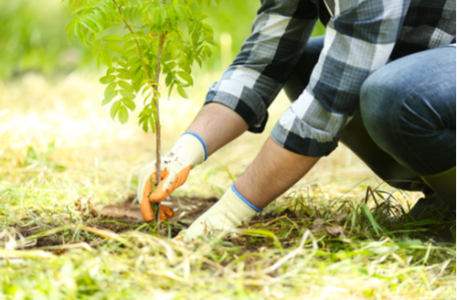
Why and How to Plant Bare-Root Trees
After months of cold winter weather across much of the U.S., spring is a welcome time to enjoy the outdoors and reconnect with the trees that share our world. It’s also an excellent time to celebrate the many ways trees enhance our environment and add to their ranks.
Arbor Day is an optimistic time to observe, appreciate, and plant trees. The first U.S. Arbor Day was celebrated 150 years ago in Nebraska.
Currently, National Arbor Day is celebrated on the last Friday of April. However, many states observe the holiday on other dates better aligned with the optimal time to plant trees in their areas.
Often, local Arbor Day celebrations include the distribution of bare-root tree seedlings. When handled and planted correctly, bare-root trees can enjoy a faster growth spurt than containerized trees, which need more time to adjust to transplanting.
Regardless of whether you're purchasing bare-root saplings or picking up free seedlings at an Arbor Day event, here’s how to give your baby tree a healthy start:
Step 1. Soak the Roots
The roots must never dry out. Immediately unwrap your tree and soak the roots in water for several hours. Before planting, gently untangle any sections wrapped together.
Step 2. Prepare the Hole
The optimal planting tool depends on the size of your tree. Young seedlings only need a small v-shaped hole deep enough for the roots to extend downward fully. A shovel with a flat blade usually works well. If you’re planting many seedlings, you may want to buy a planting bar (also called a dibble bar) specially designed for planting trees.
Taller saplings require a larger, u-shaped hole that is slightly deeper than the extended roots and twice as wide as the roots. Typically, a standard curved shovel with a pointed tip gets the job done.
Step 3. Pack the Soil
Slowly and carefully refill the hole with the same soil. Do not amend the dirt with anything else, like peat moss, potting soil, or fertilizer. Instead, gently but firmly pack the soil around the roots so no air pockets remain.
Step 4. Water and Mulch
After planting, give your tree a good soaking, so the soil is compressed around the roots and keeps them damp. If the hole is at least two feet in diameter, you may want to add a couple of inches of mulch to help retain moisture and prevent weed growth. However, don’t bring the mulch in direct contact with the tree trunk.
Step 5. Take Protective Measures
Many backyard visitors, including rabbits and deer, love to eat tender, young seedlings, and saplings. A wire mesh tube positioned around each new plant will help protect them.
Step 6. Water Appropriately
Young trees need more frequent watering until they are well established. However, it’s also possible to water them too often, which causes their roots to remain shallow instead of seeking out deeper water sources.
For the best results, deeply water newly planted trees every seven to ten days, then let the ground dry out before the next watering.
